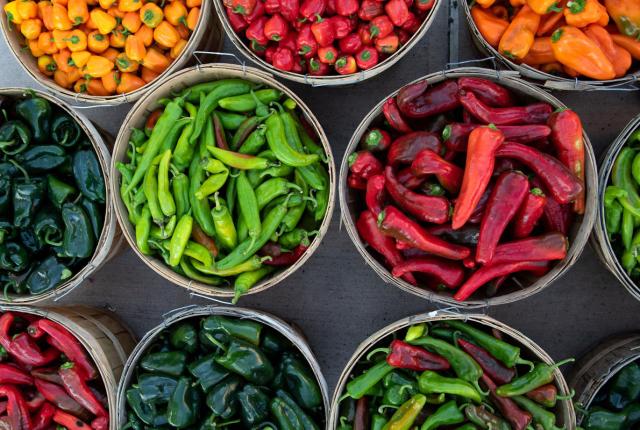HOW DO YOU MAKE CHILE? It’s a common question in our capsicum-crazed state, a culinary query that sounds deceptively simple. Reach for a recipe and heat up a pot? Almost, but not. Long before the stove is lit, crucial matters must be probed. Red or green? Mild or hot?
Like the season’s first chile plants, which sprout small flowers shortly after the seedlings emerge, one consideration blooms into another as the chile novice grows into a connoisseur. There are questions of geography: Chimayó, La Mesa, or Hatch? Preferences in pod size, heat, and type: Big Jim? Sandía? Española Improved? And for this weather- and water-dependent crop, highly vulnerable to insects and disease, there are long-standing environmental concerns.
Myriad factors must converge before you sink a fork into your favorite rich red enchilada or savor a special medley of green. It’s a wonder—maybe even a miracle—we get to eat it at all. And yet, without it, it’s safe to say we wouldn’t be fully New Mexican.
From the small chile patches in the north to the vast agri-huertas, or irrigated fields, of the south, our legacy of chile runs deep in our soils and our souls. Centuries of seed selection and cultivation have readied our distinctive, sun-kissed pods for the pleasure and, yes, the pain of the palate. The medically proven effect is a rush of endorphins that tempts our taste buds to want more. Our ever-growing appetite for chile’s flavors fuels a multi-million-dollar industry and an international brand.
The question, then, is not so simple. Like many things here, the making of chile belies a complex multicultural backstory. This story straddles themes of nature, science, tradition, and time. It simmers in the stew of our uniquely New Mexican experience, a slow-cooked mix of history, heritage, and home.

ON THE COVER
Feb./March 1996
Micah Hahn created the imaginative computer illustration for this special issue focused on chile.
The story of New Mexico chile is a 9,000-year history of the Americas, where the chiltepin plant first grew wild in the jungles of Bolivia and Peru. As predators bit into its berry-size fruit, the plant bit back, having developed a heated system of defense. Only migratory birds could withstand the counterattack, and their chile-seeded droppings took root across the landscape.
Chiltepin’s potent flavor and curative properties were prized by Indigenous peoples—including the Inca, the Maya, and the Aztecs—for ceremonial, medicinal, and culinary use. The Aztecs domesticated the crop, cultivating the Capsicum annuum species, which they called chilli. By the Spanish conquest of 1519, they had developed dozens of cultivars—poblanos, serranos, jalapeños, and more. Spanish chronicler Bernardino de Sahagún described the Aztecs’ chilli cuisine, citing such specialties as lobster with red and frog with green. European colonists quickly adopted the crop and changed its Nahuatl name to a Spanish spelling: chile.
Exactly when chile arrived in New Mexico is a heated subject. Indigenous cultures here traded with Indigenous cultures to the south long before the Spanish incursion of 1598. Presumably, chile would have been a valuable item of exchange. The first chiles documented as being planted in the state grew in places where both Indigenous and Hispano cultures thrived, and where those who came after still sow their heirloom seeds.
In New Mexico, where warm days and cool nights proved ideal for growing, the perennial chile plant was adapted as an annual. Chile soon graced dinner tables across the territory, while the Santa Fe Trail and the railroad carried it to other regions. But the most significant event in the crop’s early development occurred in Las Cruces in 1921, when Fabián García, a Mexico-born researcher at the New Mexico College of Agriculture and Mechanic Arts, introduced New Mexico No. 9.
García cross-bred three popular chiles—the brown pasilla, the scarlet colorado, and the richly dark negro—into a pod that was longer, milder, and redder than previous types. The high-yield cultivar was a staple for farmers for the next 30 years. García’s innovation gave birth to the U.S. chile industry and launched today’s Chile Pepper Institute at NMSU.
In the early 1990s, I pursued my passion for chile, trudging through fields statewide for two years to write a book on the subject. Inevitably, the journey led me back to the dinner table of my Santa Fe childhood.
There, my mother, Zenaida, blended dried ristras of red with onion and pork into a robust sauce we often ate by the bowlful. She hand-peeled pods of green that my father, Reyes, roasted on the backyard grill. These were chopped and tossed into a chunky pork-and-potato stew. Red or green, in varying preparations, theirs was a collaborative cuisine steeped in the spicy aroma of love and tradition.
My mother is now nearly 100, and her chile offerings are rare gastronomic gifts. My late father’s joy in eating the hottest chile he could take is the stuff of family legend. Times change, but the essence of my chile home remains. Their example is the recipe for making my own countless chile meals.
I’ve imagined the meal I would make if I knew it was my last. Stacked blue corn pork enchiladas, swimming in a picante pool of red. Extra onions. Cheese bubbling at the edges. Egg over easy on top.
All of which brings me back to you. How do you make your chile?
Read more: In 1969, a newcomer began learning a lifetime of lessons from the acequia system.
OUR CHILES RELLENOS CAN'T BE BEAT
“I’m Mexican American, and I think chiles rellenos bring a bit of both cultures together. We use chile grown in Hatch. We roast them, which gives a lot of flavor. Our secret is we add a tiny bit of sour cream to the filling. It’s a family recipe that my mother adapted. We’ve been open for 12 years, and chiles rellenos have always been on our menu.”
—Zaide Zarazua Fernandez, manager at La Cueva Cafe, in Taos




